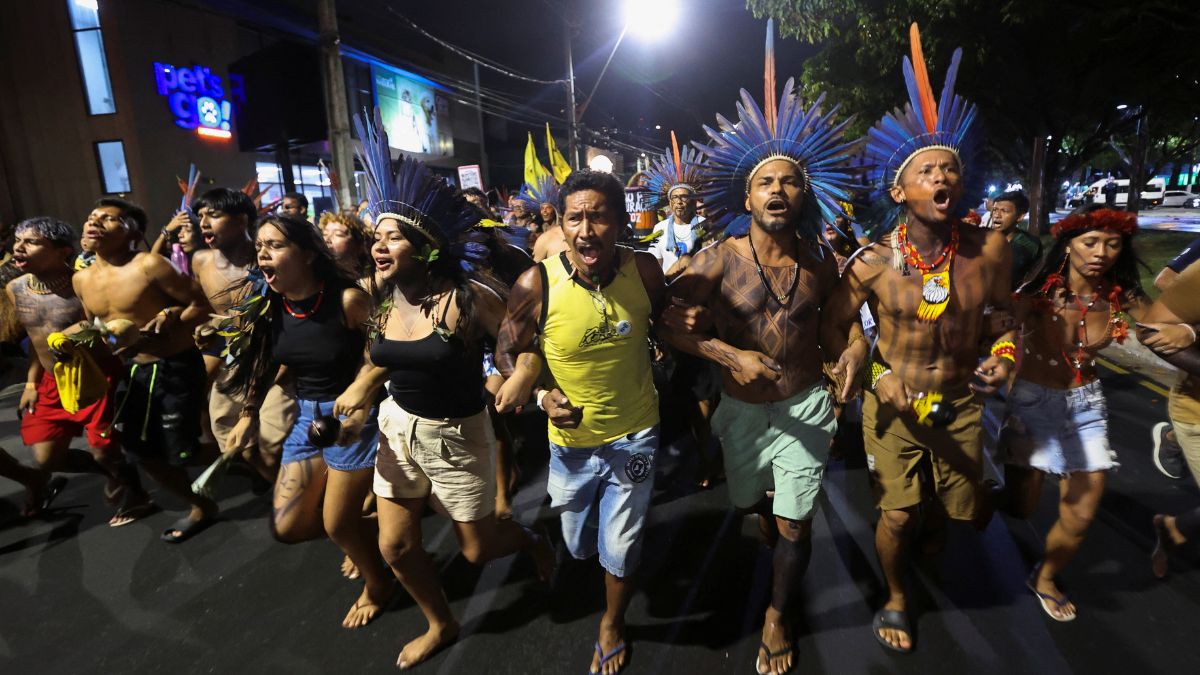Tensions erupted at the Cop30 climate summit in Brazil ’s Belem city on Tuesday night, after a group of protesters stormed the main venue and clashed with UN security guards.
Videos from the scene showed chaotic moments at the entrance as demonstrators chanted slogans and held placards reading “Our forests are not for sale”, before being restrained by security personnel. The UN later confirmed that a few guards sustained minor injuries and that parts of the venue were damaged during the scuffle.
The incident has thrown a spotlight on rising anger among Indigenous and environmental groups, who accuse world leaders of sidelining them in talks that directly affect their lands and livelihoods.
Here’s what happened.
Tussle breaks out at Cop30
Dozens of Indigenous activists and environmental campaigners tried to storm the Cop30 venue , shouting slogans like “Our land is not for sale” and waving flags and placards. Many wore T-shirts reading “Juntos” (Together).
According to Reuters, the demonstrators chanted and waved banners before being forcibly removed by security.
Agustin Ocana of the Global Youth Coalition told the AP that several protesters were chanting, “They cannot decide for us without us,” reflecting long-standing frustrations over Indigenous participation in the conference.
As clashes broke out near the security gates, Ocaña said he witnessed protesters and guards hitting each other with small plastic bins. One guard was reportedly bleeding from a head injury. Following the confrontation, protesters left the premises as fire brigade officers formed a cordon to block the entrance. It remains unclear who organised the intrusion.
“At last, something has happened here,” Juan Carlos Monterrey-Gómez, a Panamanian climate negotiator, told The Guardian.
Security inside the Cop30 venue is managed by the UN , while local authorities handle the surrounding area. UN police officers were later seen urging attendees to evacuate the site, made up of vast air-conditioned tents.
“The Indigenous movement wanted to present its demands inside the blue zone but were not allowed in,” said Joao Santiago, a professor at the Federal University of Para.
What’s behind the protests?
Many protesters at Cop30 say they feel shut out of decisions that deeply affect their lives. Indigenous leaders from across the Amazon argue that while they’re being asked to protect the world’s largest rainforest, they have little real power in shaping how their ancestral lands are managed.
One leader from the Tupinambá community told Reuters, “We can’t eat money. We want our lands free from agribusiness, oil exploration, illegal miners and illegal loggers.”
Maria Clara, a protester with the Rede Sustentabilidade Bahia association, told AFP that her goal was to draw attention to the ongoing struggles of Indigenous peoples. “These voices are ignored,” she said. “They entered the Cop30 venue to protest the fact that the Cop will end but the destruction continues.”
Agustin Ocana from the Global Youth Coalition said that many Indigenous groups were angry seeing millions spent on building “a whole new city” in Belem for Cop30, while communities elsewhere still lack basic support for education, healthcare and forest protection. “They’re not doing this because they’re bad people,” Ocaña said. “They’re desperate, trying to protect their land and the [Amazon] river.”
About the Cop30 meet in Brazil
Delegates from nearly 200 countries are in Belem, Brazil, for the Cop30 climate talks, which officially run from 10 to 21 November. The conference marks ten years since the historic Paris Agreement , when nations pledged to limit global temperature rise to 1.5 degrees Celsius.
This year’s summit carries special weight, as it takes place in the heart of the Amazon rainforest, one of the world’s most critical ecosystems in the fight against climate change.
Unlike the previous three Cop summits, which were hosted in more tightly controlled political environments, Brazil is encouraging public participation. The government has said it wants this Cop to be more inclusive, allowing space for civil society, activists, and street demonstrations to have a voice.
)
Last week, Brazil’s Minister for Indigenous Peoples, Sonia Guajajara, said that Cop30 would be “the best Cop in terms of Indigenous participation.” She said the conference aims to bridge the gap between world leaders and those living on the frontlines of the climate crisis.
Over the past week, activist movements have been steadily growing around the summit, organising up to four peaceful demonstrations a day. More demonstrators are expected to arrive on Wednesday in a flotilla of around 100 boats, led by two of the Amazon’s most respected Indigenous leaders, Raoni Metuktire and Davi Kopenawa Yanomami.
With input from agencies
)